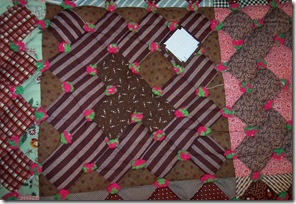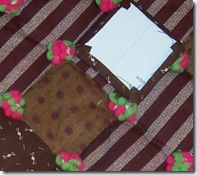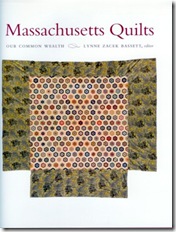Have any of you who own antique quilts notice your once perfect quilt suddenly has cracking in the brown fabrics? We all have, as pre-1900 dark brown dyed fabric is prone to becoming brittle due to tannin and iron mordants in the dyes. (They used to use iron pots for dyes that needed iron to help the fabric retain the dye, a 2-fer)
Over time the fabric dries out and splits, or it get's wet and splits, or the sun shines on it too long and it splits, or you pack it away and it splits. I think you are get the picture.
Dark brown 19th century cotton fabrics are similar to silks used in crazy quilts, the silk will deteriorate and you can not stop it once it starts. You can help prevent it from starting
maybe, or better put, increase the number of years before the deterioration begins. Oh, wait, you're telling me that you want to have it out? Oh, well, then you can postpone the deterioration by a number of months. My gosh, I am so negative here- I'm smiling. I hope you are.
That said, here is a repair I did this past week in a most interesting looking quilt that I bought in Arizona years ago when antique store shopping with the two wild and crazy lovely ladies, Audrey and Dee, who own and operate the quilt retreat camps with national teachers Quilting in the Pines and Quilting in the Desert. We all had a good laugh when we saw this quilt.
 It is a pink and brown scrap (fabulous 1870-80s fabrics, all new or unused) album block quilt in nearly perfect condition, with wool batting, and tied with pink and green yarn to a 1930-40s back fabric! Each yarn tie, and there are many, is made with both colors of yarn, sort of tufted and it is held down and brought through the thick wool bat with a thick sewing thread.
It is a pink and brown scrap (fabulous 1870-80s fabrics, all new or unused) album block quilt in nearly perfect condition, with wool batting, and tied with pink and green yarn to a 1930-40s back fabric! Each yarn tie, and there are many, is made with both colors of yarn, sort of tufted and it is held down and brought through the thick wool bat with a thick sewing thread.
The thick dense batting saved this quilt from splitting much more than it could have with a thinner bat or fewer ties. I have stored it with as little folding as possible, in a closet, on top of other quilts, with no weight on it. Still, deterioration has set in on two blocks.
 I fixed the most serious and obvious loss of fabric, after taking off the damaged fabric completely, arggg, at some point, and I can't recall why. I know better now to leave
I fixed the most serious and obvious loss of fabric, after taking off the damaged fabric completely, arggg, at some point, and I can't recall why. I know better now to leave
the old fabric underneath and applique on top of it. I used an old piece of fabric, c. 1900, that matched the best with the rest of the quilt. I think it turned out well.
In the words of Nancy Kirk, I made an "honest p atch." this means I'm not trying to fool anybody, so my stitches show, but it blends well. It was not easy working on a quilt this thick and naturally, my stitches did not go all the way through. I appliqué the patch on top of the seams and into the batting when there were no seams. It is made with 1 rectangle and 2 squares and I used brown DMC thread.
atch." this means I'm not trying to fool anybody, so my stitches show, but it blends well. It was not easy working on a quilt this thick and naturally, my stitches did not go all the way through. I appliqué the patch on top of the seams and into the batting when there were no seams. It is made with 1 rectangle and 2 squares and I used brown DMC thread.
Soon I will be done and show you my "honest patch" on the acid green fabric in the pre-Civil War quilt TOP. Where is that batting when you need it? :)
You are invited to join our book discussion and interview with Lynne Bassett, the quilt historian who edited the newest state quilt project book, Massachusetts Quilts: Our Common Wealth, in a group tel-event on March 16th, Monday evening, 5 PM Pacific time. Lynne will answer your questions about particular quilts and other questions that arise as you read this fantastic book. Read more about it on Women On Quilts.
and interview with Lynne Bassett, the quilt historian who edited the newest state quilt project book, Massachusetts Quilts: Our Common Wealth, in a group tel-event on March 16th, Monday evening, 5 PM Pacific time. Lynne will answer your questions about particular quilts and other questions that arise as you read this fantastic book. Read more about it on Women On Quilts.
Great looking repair...wow! I love those ties!
ReplyDelete